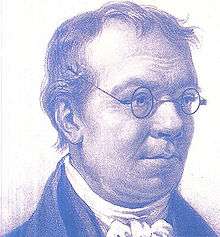Johann Wilhelm Wilms

Johann Wilhelm Wilms (March 30, 1772 (baptized) – July 19, 1847) was a Dutch-German composer, best known for setting the poem Wien Neêrlands Bloed to music,[1] which served as the Dutch national anthem from 1815 to 1932.
Wilms was born in Witzhelden near Solingen. After lessons from his father and oldest brother in piano and composition, Wilms studied flute on his own. He moved to Amsterdam in 1791 where he played flute in two orchestras and was soloist in Mozart and Beethoven piano concertos, giving them their Dutch premieres.
He also taught piano at the Koninklijk Nederlandsch Instituut voor Wetenschappen, interviewed applicants for church organist positions, judged composition competitions and wrote for the Allgemeine musikalische Zeitung, a publication he once used as a soapbox to complain about the lack of performance of music by contemporary Dutch composers like himself.
As the events of the French Revolution affected the Netherlands, Wilms wrote several patriotic hymns. However, following the fall of Napoleon, and the return of the House of Orange to power, Wilms in 1816 won the open competition for the new Dutch anthem with Wien Neêrlandsch bloed (with lyrics by Hendrik Tollens), leading to lots of commission from churches and other organizations.
For 23 years Wilms was the organist at a Mennonite church in Amsterdam, where he died.
Symphonies
Wilms wrote seven symphonies, the one in F major was lost and the others sank into obscurity after his death. The chronology of the five early symphonies is not clear even to experts.
His Symphony No. 6 in D minor, which won first prize at the Société des Beaux-Arts Ghent, and Symphony No. 7 in C minor were recorded in 2003 by Concerto Köln for Deutsche Grammophon.
Due to a misunderstanding about publication dates, conductor Werner Ehrhardt at first thought that Wilms had lived in a later period and therefore had written music in an antiquated style. But after being straightened out, given the enthusiasm his ensemble felt for this music, Ehrhardt decided to record these two symphonies anyway. Scholars are more certain these are later works because of their use of cyclic form.
Selected list of works
- Concert Overture in E major [2]
- Flute Concertino in G minor
- Sonata in D major for Piano Four-Hands, Opus 7 [3]
- Piano Concerto No. 1 in E major, Opus 3
- Symphony No. 1 in C major, Opus 9
- Symphony No. 2 in F major, Opus 10 (lost)
- Piano Concerto No. 2 in C major, Opus 12[4]
- Piano Sonata in B-flat major, Opus 13 [3]
- Symphony in E-flat major, Opus 14 [2][5]
- Three Violin Sonatas, Opus 21 [3]
- Piano Quartet in C major, Opus 22 [3]
- Symphony in C minor, Opus 23 [2]
- Flute Concerto in D major, Opus 24[4]
- Two String Quartets (in G minor (ca. 1806) [6][7] and A major), Opus 25. Published in 2007.[2][3]
- Sonata in C major for Piano Four-Hands, Opus 31
- Flute Sonata in D, Opus 33 [3]
- Sonata in B-flat for Piano Four-Hands, Opus 41 (ca. 1813) [2][3]
- Symphony No. 5 in D major, Opus 52 [2][5]
- Symphony No. 6 in D minor, Opus 58
- Symphony No. 7 in C minor
- Wien Neêrlandsch bloed
- Overture in D major [2]
- Overture in E-flat major (edited by B. Hagels and published in 2006) [2]
References
- Bokum, Jan ten. 2001. "Wilms, Johann Wilhelm". The new Grove dictionary of music and musicians, ed. S. Sadie and J. Tyrrell. London: Macmillan. ISBN 1-56159-239-0.
- Brook, Barry S. (editor-in-chief), and Barbara B. Heyman (associate editor). 1986. The Symphony: 1720–1840 Series C, Volume XIII (Knecht, Wilms, Kalliwoda). New York: Garland Publishing, Inc. ISBN 0-8240-3860-6.
External links
- ↑ Joop W. Koopmans; Arend H. Huussen Jr. (22 May 2007). Historical Dictionary of the Netherlands. Scarecrow Press. pp. 1–. ISBN 978-0-8108-6444-3.
- 1 2 3 4 5 6 7 8 "New York Public Library OPAC". Retrieved 2007-11-04.
- 1 2 3 4 5 6 7 "National Library of the Netherlands Online Catalog". Koninklijke Bibliotheek, National Library of the Netherlands. Retrieved 2007-10-03.
- 1 2 "Recording Announcement of Piano Concerto No. 2 and Flute Concerto". Retrieved 2009-07-28.
- 1 2 "Concertzender Broadcast with Quicktime Sound of Symphonies Opus 14 and 52". Retrieved 27 March 2009.
- ↑ "From Catalog Listing of a Release of a recording of Wilms' Opus 25/1 Quartet". Records International. May 1999. Retrieved 2007-10-03.
- ↑ Hall, Charles J. (2002). Chronology of Western Classical Music. New York: Routledge/Taylor&Francis. p. 1155. ISBN 0-415-94217-9.
- Symphonies with Concerto Köln on Deutsche Grammophon
- Local Wilms website from his place of birth - the village Witzhelden
- Free scores by Johann Wilhelm Wilms at the International Music Score Library Project